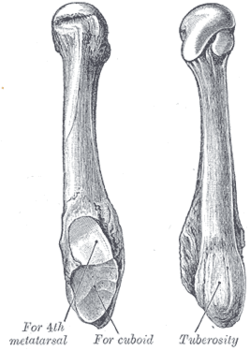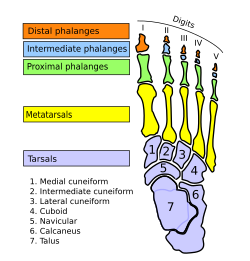| Fifth metatarsal bone | |
|---|---|
 The fifth metatarsal. (Left.) | |
 Bones of the right foot. Dorsal surface. Fifth metatarsal bone is the yellow bone farthest the right | |
| Details | |
| Identifiers | |
| Latin | os metatarsale V |
| TA2 | 1502 |
| FMA | 24506 |
| Anatomical terms of bone | |
The fifth metatarsal bone is a long bone in the foot, and is palpable along the distal outer edges of the feet. It is the second smallest of the five metatarsal bones. The fifth metatarsal is analogous to the fifth metacarpal bone in the hand.[1]
As with the four other metatarsal bones it can be divided into three parts; a base, body and head. The base is the part closest to the ankle and the head is closest to the toes. The narrowed part in the middle is referred to as the body (or shaft) of the bone. The bone is somewhat flat giving it two surfaces; the plantar (towards the sole of the foot) and the dorsal side (the area facing upwards while standing).[1] These surfaces are rough for the attachment of ligaments. The bone is curved longitudinally, so as to be concave below, slightly convex above.
The base articulates behind, by a triangular surface cut obliquely in a transverse direction, with the cuboid; and medially, with the fourth metatarsal. The fifth metatarsal has a rough eminence on the lateral side of its base, known as the tuberosity or the styloid process. The plantar surface of the base is grooved for the tendon of the abductor digiti quinti.
The head articulates with the fifth proximal phalanx, the first bone in the fifth toe.
A strong band of the plantar aponeurosis connects the projecting part of the tuberosity with the lateral process of the tuberosity of the calcaneus.
- ^ a b Bojsen-Møller, Finn; Simonsen, Erik B.; Tranum-Jensen, Jørgen (2001). Bevægeapparatets anatomi [Anatomy of the Locomotive Apparatus] (in Danish) (12th ed.). Munksgaard Danmark. p. 246. ISBN 978-87-628-0307-7.